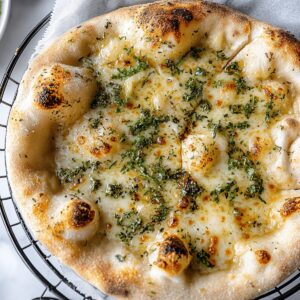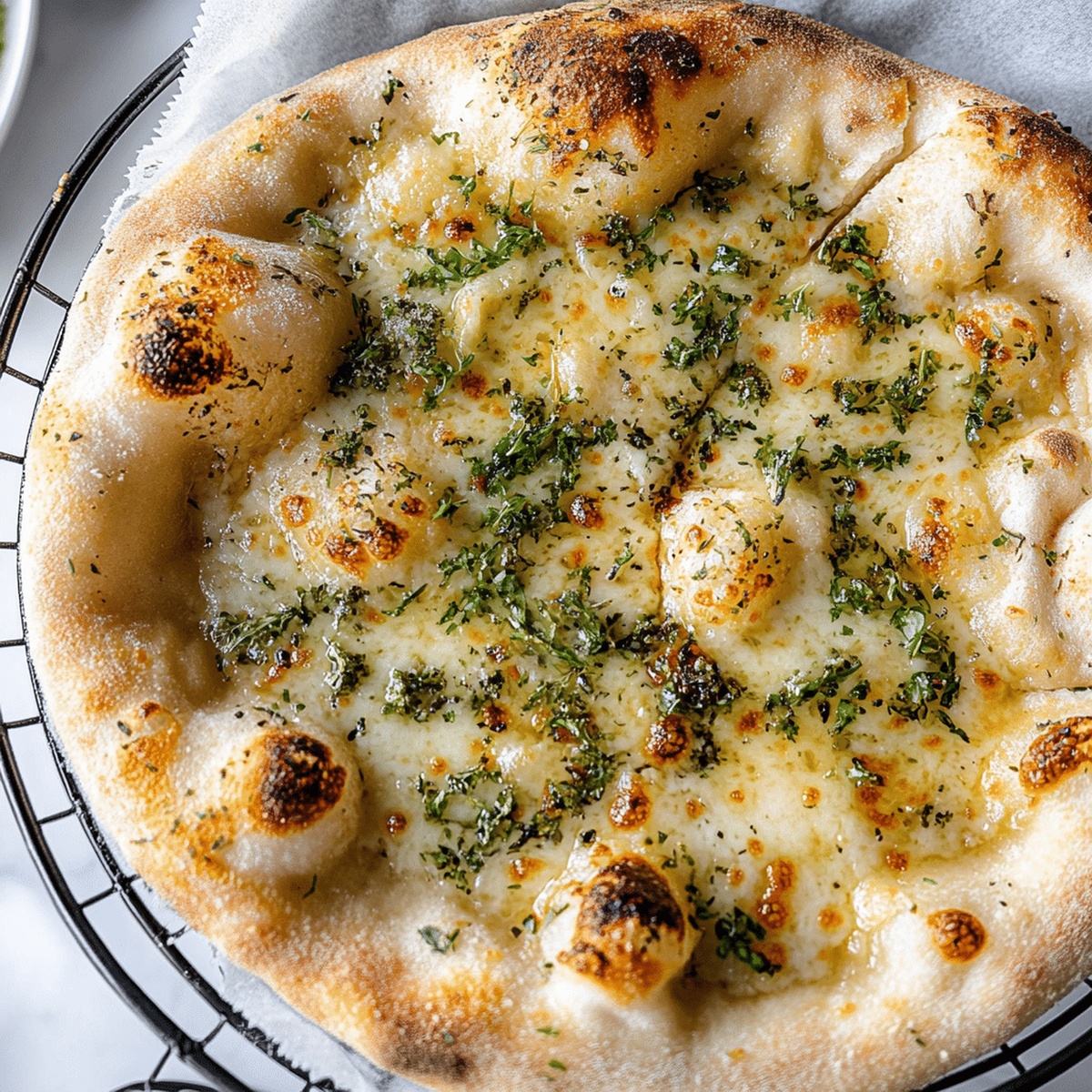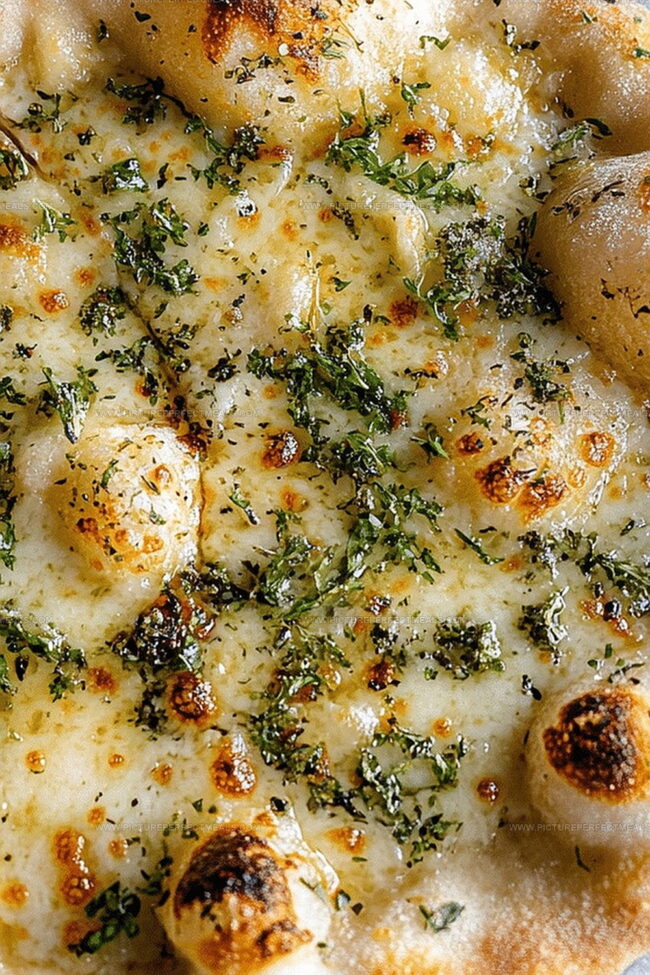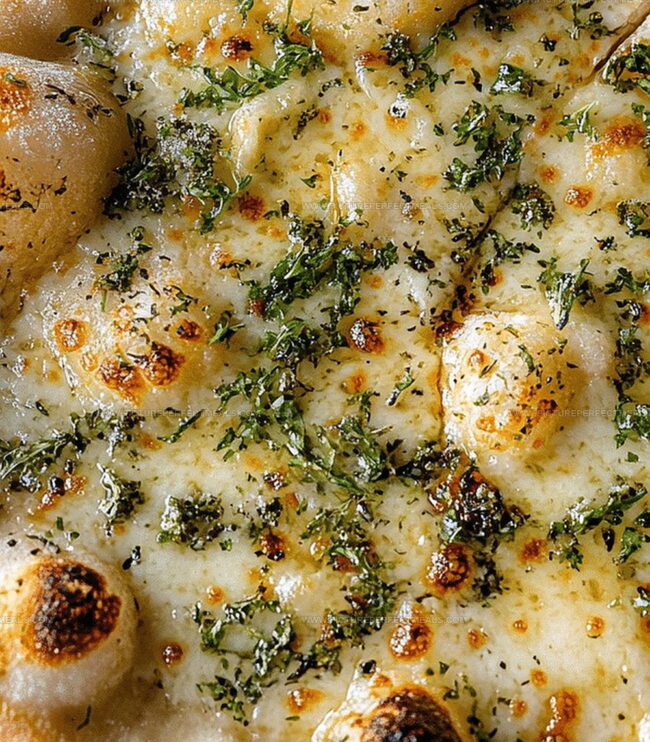Creamiest Buttery Garlic Pizza Recipe You’ll Ever Make
Check out this garlic pizza that has completely transformed my weekend cooking routine.
Crispy edges and rich, aromatic flavors make this dish irresistible for casual gatherings.
Cheese melts perfectly across a golden crust that hints at pure comfort.
Simple ingredients come together in surprisingly delightful ways you’ll want to master.
Each bite promises a delectable journey through robust garlic and smooth butter undertones.
Home cooks can easily recreate this restaurant-worthy masterpiece with minimal kitchen skills.
Let’s unlock the secret to making this mouthwatering pizza that will impress everyone at your table.
Why Buttery Garlic Pizza Deserves a Spot on Your Table
What You’ll Need for Buttery Garlic Pizza
Pizza Base Ingredients:Flour and Seasoning:Moisture and Binding Ingredients:Buttery Garlic Pizza Cooking Walkthrough
Step 1: Activate Yeast Mixture
Grab a small bowl and pour in warm water. Sprinkle sugar and add yeast. Stir gently and let the mixture sit quietly. Watch for tiny bubbles to form and the surface to become foamy, which signals your yeast is ready to work its magic.
Step 2: Mix Dry Ingredients
Take a large mixing bowl and combine:Create a small well in the center of the dry ingredients.
Step 3: Combine Wet and Dry Ingredients
Pour the activated yeast mixture into the flour well. Add olive oil. Mix everything together using a wooden spoon or your hands until a shaggy dough starts to form.
Step 4: Knead the Dough
Transfer the dough to a clean, lightly floured surface. Start kneading by pushing and folding the dough. Continue this motion for 8-10 minutes. The dough will transform from rough and sticky to smooth and stretchy.
Step 5: First Rise
Lightly grease a clean bowl with olive oil. Place the kneaded dough inside and cover with a clean kitchen towel. Let the dough rest in a warm, draft-free spot for 1-2 hours. The dough will double in size, becoming puffy and soft.
Smart Suggestions for Buttery Garlic Pizza Success
Keep Buttery Garlic Pizza Tasting Great Later
Buttery Garlic Pizza Pairings You’ll Crave
Buttery Garlic Pizza Variations Worth Trying
Buttery Garlic Pizza Q&A You Should Know
Check for frothiness and bubbling after 5-10 minutes in warm water with sugar. If no activity occurs, your yeast might be expired or the water temperature was incorrect.
Yes, you can prepare the dough and refrigerate it for up to 24 hours before using. This can actually enhance the flavor and make the dough easier to work with.
Ensure your environment is warm and draft-free. Ideal rising temperature is around 75-80°F. If it’s too cold, the yeast won’t activate effectively. Consider placing the dough in a slightly warm oven (turned off) or near a warm spot in your kitchen.
Use a pizza stone or a preheated baking sheet, and roll the dough thin. Brush the edges with olive oil and bake at a high temperature (around 450-475°F) to achieve a crispy texture.
Print
Buttery Garlic Pizza Recipe
- Total Time: 12 hours 32 minutes
- Yield: 8 1x
Description
Homemade Buttery Garlic Pizza delivers an irresistible symphony of flavors that dance across your palate with rich, comforting Italian charm. Melted cheese, golden crust, and robust garlic notes will make you crave another slice of this delectable culinary creation.
Ingredients
Pizza Dough:
- 2 ¼ teaspoons (1 packet) active dry yeast
- 1 ½ cups (360 milliliters) warm water
- 3 ½ cups (440 grams) all-purpose flour
- 1 teaspoon sugar
- 1 teaspoon salt
- 2 tablespoons (30 milliliters) olive oil
Garlic Butter Topping:
- ¼ cup (57 grams) unsalted butter
- 4 garlic cloves, minced
- ½ teaspoon salt
- ½ teaspoon black pepper
- 1 teaspoon dried oregano
- ½ teaspoon red pepper flakes (optional)
Cheese Topping:
- 2 cups (226 grams) shredded mozzarella cheese
- ½ cup (50 grams) grated Parmesan cheese
- Fresh basil or parsley, chopped (for garnish)
Instructions
- Activate the yeast by whisking it into lukewarm water with a touch of sugar, allowing the mixture to bloom and become foamy for about 7 minutes.
- Create a flour foundation in a spacious mixing vessel, incorporating salt and forming a well in the center for the activated yeast and olive oil.
- Gently fold and press the ingredients together, transforming them into a cohesive, slightly sticky dough with a uniform texture.
- Transfer the dough onto a lightly dusted work surface, using rhythmic kneading motions to develop gluten and create a smooth, springy consistency.
- Nestle the dough into a lightly oiled ceramic bowl, draping a clean kitchen towel over the top to trap warmth and encourage rising.
- Allow the dough to rest and expand, roughly doubling in volume, which typically takes approximately 1-1.5 hours in a draft-free environment.
- After rising, softly deflate the dough with gentle pressing, preparing it for shaping and topping with garlicky, buttery goodness.
Notes
- Keep water temperature between 100-110°F to activate yeast perfectly without killing it.
- Add a pinch of extra sugar helps yeast bloom faster and creates more robust fermentation.
- Use bread flour for chewier, more professional-style pizza crust with stronger gluten development.
- Letting dough rise slowly in cool environment develops deeper, more complex flavor profile.
- Prep Time: 20 minutes (plus 12 hours rising time)
- Cook Time: 12 minutes
- Category: Lunch, Dinner, Snacks
- Method: Baking
- Cuisine: Italian
Nutrition
- Serving Size: 8
- Calories: 350
- Sugar: 1 g
- Sodium: 420 mg
- Fat: 18 g
- Saturated Fat: 8 g
- Unsaturated Fat: 10 g
- Trans Fat: 0 g
- Carbohydrates: 38 g
- Fiber: 2 g
- Protein: 12 g
- Cholesterol: 30 mg




Daves Miller
Contributing Chef & Culinary Educator
Expertise
Education
Sullivan University, Louisville, Kentucky
White Mountains Community College, Berlin, New Hampshire
Daves is the friendly face guiding you through flavorful, fuss-free recipes at Picture Perfect Meals.
He studied culinary arts at Sullivan University and embraced Baking and Pastry Arts at White Mountains Community College. Daves specializes in comforting meals with vibrant flavors, highlighting fresh, seasonal ingredients.